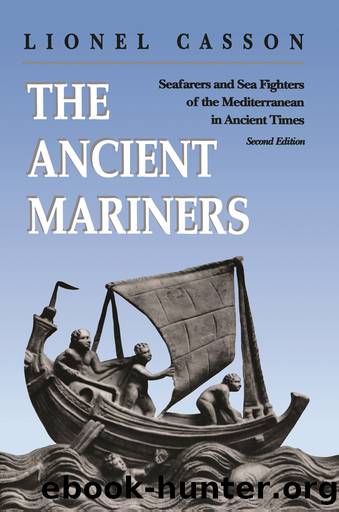The Ancient Mariners by Lionel Casson;

Author:Lionel Casson; [Casson;, Lionel]
Language: eng
Format: epub
ISBN: 9780691014777
Publisher: PrincetonUP
Published: 2020-04-09T00:00:00+00:00
Most commentators are convinced that Hanno succeeded in making his way a considerable distance down the coast. They point to phenomena he records that today are commonplace in explorersâ accounts of journeys to Africa: the jungle, the beating of tom-toms, the enormous grass fires that natives kindle to burn off stubble and help the following yearâs crop, the ubiquitous monkeys. What his interpreters called âgorillasâ must be some kind of large ape, but hardly what we know by that name; his men were tough but not up to going after gorillas barehanded, even females. Chimpanzees or baboons have been suggested. (It was an American missionary, Thomas Savage, who in 1847 applied Hannoâs term to the mighty apes that now bear it.)
Exactly how far did he get? Conservative commentators think that he stopped short of the calms and heat of the Gulf of Guinea and pushed no farther than Sierra Leone, that the Western Horn is Bissagos Bay, that the Chariot of the Gods is Mount Kakulima in French Guinea which, although relatively low (ca. 3,000 feet), stands out in the midst of low-lying ground, and that the Southern Horn is Sherboro Sound. Others, more bold, take him as far as the Cameroons, arguing that the Chariot of the Gods is better identified with Mount Cameroon, the tallest peak in West Africa (13,370 feet) and a volcano to boot.
Finally there are the skeptics who feel that Hanno actually got only a short way down the coast and that the part of the voyage during which his dramatic experiences took placeâthe river full of crocodiles, the Western Horn with a fiery zone that extended all the way to the Southern Horn, the flame that seemed to reach the starsâwere added by armchair geographers writing centuries later who attributed to Hanno their own fantasies about the shape and nature of Africa incognita. As in the case of the Phoenician circumnavigation of Africa, we will never know for sure. And, like that venture, Hannoâs had no effect on subsequent history. Most of the west coast of Africa was to remain outside of European knowledge right up to the fifteenth century, when Prince Henry the Navigator successfully pressed his captains to sail ever farther south along its shores.
For over a century after Hannoâs return, mariners stayed within the Mediterranean. The Carthaginians were satisfied to exploit the settlements Hanno had founded, and their hold on the Strait of Gibraltar kept others out of the Atlantic. Then, as the fourth century B.C. drew to a close, Pytheas of Marseilles entered the picture. He slipped through the blockade and was off on a unique and daring voyage of discovery.
âIn fact there is no star at the pole but an empty space close to which lie three stars; these, taken with the point of the pole, make a rough quadrangle, as Pytheas of Marseilles tells us.â It is only through stray notices such as this, scattered among the writings of ancient astronomers and geographers, that we know of this
Download
This site does not store any files on its server. We only index and link to content provided by other sites. Please contact the content providers to delete copyright contents if any and email us, we'll remove relevant links or contents immediately.
| Africa | Americas |
| Arctic & Antarctica | Asia |
| Australia & Oceania | Europe |
| Middle East | Russia |
| United States | World |
| Ancient Civilizations | Military |
| Historical Study & Educational Resources |
The Dawn of Everything by David Graeber & David Wengrow(1570)
The Bomber Mafia by Malcolm Gladwell(1523)
Facing the Mountain by Daniel James Brown(1429)
Submerged Prehistory by Benjamin Jonathan; & Clive Bonsall & Catriona Pickard & Anders Fischer(1376)
Tip Top by Bill James(1291)
Wandering in Strange Lands by Morgan Jerkins(1282)
Evil Geniuses: The Unmaking of America: A Recent History by Kurt Andersen(1272)
Red Roulette : An Insider's Story of Wealth, Power, Corruption, and Vengeance in Today's China (9781982156176) by Shum Desmond(1267)
The Way of Fire and Ice: The Living Tradition of Norse Paganism by Ryan Smith(1259)
Driving While Brown: Sheriff Joe Arpaio Versus the Latino Resistance by Terry Greene Sterling & Jude Joffe-Block(1231)
American Kompromat by Craig Unger(1214)
F*cking History by The Captain(1197)
It Was All a Lie by Stuart Stevens;(1193)
American Dreams by Unknown(1155)
Treasure Islands: Tax Havens and the Men who Stole the World by Nicholas Shaxson(1153)
Evil Geniuses by Kurt Andersen(1144)
White House Inc. by Dan Alexander(1123)
The First Conspiracy by Brad Meltzer & Josh Mensch(1076)
The Fifteen Biggest Lies about the Economy: And Everything Else the Right Doesn't Want You to Know about Taxes, Jobs, and Corporate America by Joshua Holland(1031)
